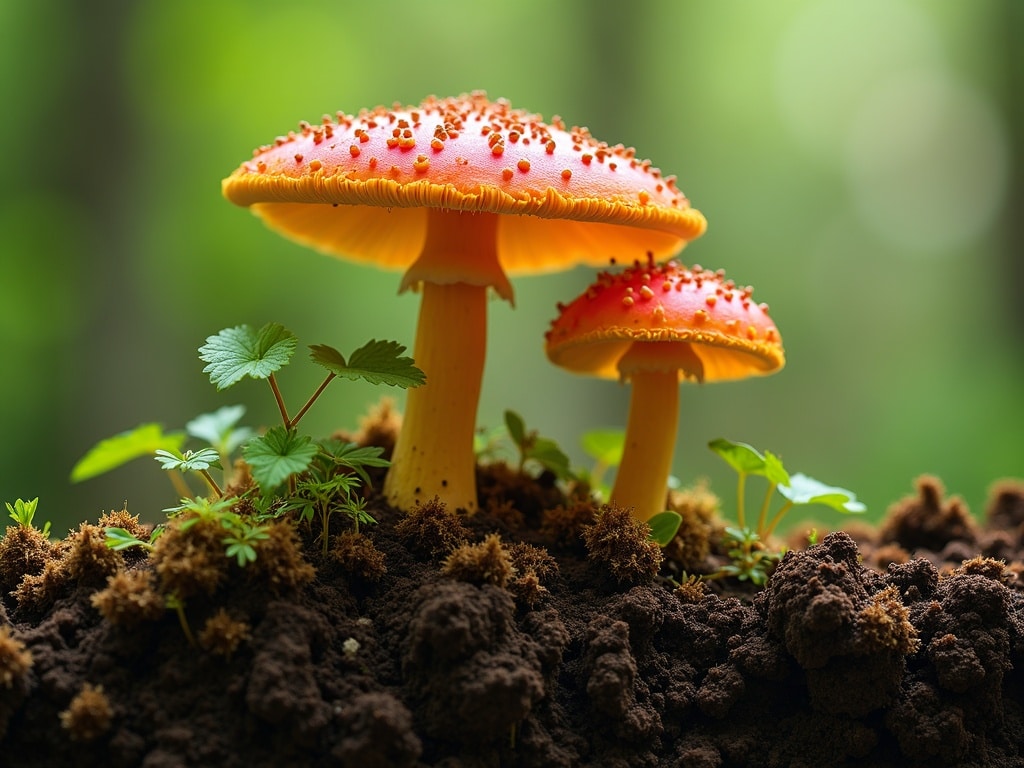Unlocking the Secrets of Mycorrhizal Fungi for Gardens: A Comprehensive Guide
Imagine a hidden network beneath your garden, a bustling metropolis of microscopic life constantly working to nourish your plants. This isn’t science fiction; it’s the fascinating world of mycorrhizal fungi, and understanding their role can revolutionize your gardening practices. For centuries, gardeners have toiled to improve their soil, often overlooking this crucial symbiotic relationship. But what if you could harness the power of these fungi to create healthier, more resilient, and more productive plants? This comprehensive guide delves into the world of mycorrhizal fungi, exploring their benefits, how to introduce them to your garden, and how to cultivate a thriving underground ecosystem.
What are Mycorrhizal Fungi?
Mycorrhizal fungi are not your average mushrooms sprouting in the forest. They are a diverse group of fungi that form a symbiotic (mutually beneficial) relationship with the roots of most plants. The term mycorrhiza literally means fungus-root. These fungi extend a vast network of hyphae (thread-like filaments) into the soil, acting as an extension of the plant’s root system.
But what’s in it for the plants, and what do the fungi get in return? It’s a classic example of a win-win situation. The fungi help the plants absorb water and nutrients, particularly phosphorus, which can be difficult for plants to access on their own. In exchange, the plants provide the fungi with carbohydrates (sugars) produced through photosynthesis. This exchange of resources is the foundation of their mutually beneficial relationship.
Types of Mycorrhizal Fungi
There are two main types of mycorrhizal fungi that are relevant to gardening:
- Ectomycorrhizal Fungi: These fungi form a sheath around the plant root and extend their hyphae into the surrounding soil. They primarily associate with trees, such as pines, oaks, and beeches. While less common in vegetable gardens, they are essential for woody ornamentals and fruit trees.
- Endomycorrhizal Fungi (Arbuscular Mycorrhizal Fungi – AMF): These are the most common type, and they are particularly beneficial for gardens. AMF penetrate the plant root cells and form structures called arbuscules, which are the sites of nutrient exchange. They associate with a wide range of plants, including vegetables, fruits, flowers, and grasses.
For most gardeners, focusing on endomycorrhizal fungi (AMF) is the most practical approach to improving soil health and plant growth.
The Benefits of Using Mycorrhizal Fungi in Your Garden
Introducing mycorrhizal fungi to your garden can unlock a wealth of benefits, leading to healthier, more productive, and more resilient plants. Here are some key advantages:
- Improved Nutrient Uptake: Mycorrhizal fungi significantly enhance the plant’s ability to absorb essential nutrients, especially phosphorus, nitrogen, and micronutrients. This is particularly important in soils that are deficient in these nutrients or where nutrient availability is limited by pH or other factors.
- Enhanced Water Absorption: The extensive network of hyphae acts like a sponge, increasing the plant’s access to water, especially during periods of drought. This leads to improved drought tolerance and reduced water stress.
- Increased Disease Resistance: Mycorrhizal fungi can protect plants from soilborne pathogens by competing for resources, stimulating the plant’s defense mechanisms, and creating a physical barrier against infection.
- Improved Soil Structure: The hyphae of mycorrhizal fungi help to bind soil particles together, improving soil structure, aeration, and water infiltration. This creates a more favorable environment for root growth and beneficial soil organisms.
- Reduced Fertilizer Dependence: By improving nutrient uptake, mycorrhizal fungi can reduce the need for synthetic fertilizers, leading to a more sustainable and environmentally friendly gardening approach.
- Increased Plant Growth and Yield: The combined effects of improved nutrient and water uptake, disease resistance, and soil structure ultimately lead to increased plant growth, vigor, and yield. You’ll see more abundant flowers, larger fruits and vegetables, and healthier overall plant performance.

How to Introduce Mycorrhizal Fungi to Your Garden
Now that you understand the benefits, how do you actually get these beneficial fungi into your garden? There are several ways to introduce mycorrhizal fungi, each with its own advantages and disadvantages.
Commercial Mycorrhizal Inoculants
The easiest and most reliable way to introduce mycorrhizal fungi is by using commercial inoculants. These products contain spores or hyphal fragments of beneficial mycorrhizal fungi. They are available in various forms, including:
- Granular Inoculants: These are typically mixed into the soil at planting time.
- Powder Inoculants: These can be sprinkled directly onto the roots of transplants or mixed with water and used as a root dip.
- Liquid Inoculants: These are typically diluted with water and used as a soil drench or root dip.
When choosing an inoculant, look for products that contain a mix of different species of endomycorrhizal fungi (AMF) to ensure compatibility with a wide range of plants. Also, make sure the product is from a reputable source and has a guaranteed spore count.
Application Methods
The key to successful inoculation is to ensure that the mycorrhizal fungi come into direct contact with the plant roots. Here are some common application methods:
- Root Dip: Before planting transplants, dip the roots in a solution of mycorrhizal inoculant. This ensures that the fungi are in close proximity to the roots from the very beginning.
- Soil Incorporation: Mix granular or powder inoculants into the soil around the planting hole. This method is suitable for both transplants and seeds.
- Seed Coating: Some seed companies offer seeds that are pre-coated with mycorrhizal fungi. This is a convenient option for direct sowing.
- Soil Drench: Apply a liquid inoculant to the soil around existing plants. This method is less effective than root dipping or soil incorporation, but it can still provide some benefit.
Considerations for Application
**Timing:The best time to apply mycorrhizal fungi is at planting time, when the roots are actively growing and most receptive to colonization.
**Dosage:Follow the instructions on the product label carefully. Over-application is not harmful, but it is also not necessary.
**Storage:Store mycorrhizal inoculants in a cool, dry place away from direct sunlight.
Creating a Thriving Mycorrhizal Ecosystem
Introducing mycorrhizal fungi is just the first step. To truly unlock their potential, you need to create a garden environment that supports their growth and activity. Here are some tips for cultivating a thriving mycorrhizal ecosystem:
Minimize Soil Disturbance
Tilling and other forms of soil disturbance can disrupt the delicate network of hyphae, harming the mycorrhizal fungi. Practice no-till or reduced-tillage gardening techniques to minimize soil disturbance and preserve the fungal network.
Avoid Excessive Fertilization
High levels of phosphorus in the soil can inhibit mycorrhizal colonization. While phosphorus is essential for plant growth, excessive fertilization can reduce the plant’s reliance on the fungi, leading to a decline in mycorrhizal activity. Use slow-release fertilizers or organic amendments to provide a steady supply of nutrients without overwhelming the soil.
Use Cover Crops
Cover crops can help to build soil health, suppress weeds, and provide a habitat for beneficial soil organisms, including mycorrhizal fungi. Choose cover crops that are known to be good hosts for mycorrhizal fungi, such as legumes and grasses.
Add Organic Matter
Organic matter, such as compost, manure, and leaf mold, provides food and habitat for beneficial soil organisms, including mycorrhizal fungi. Adding organic matter to your soil will improve its structure, fertility, and water-holding capacity, creating a more favorable environment for mycorrhizal growth.
Avoid Fungicides
Fungicides can harm mycorrhizal fungi, so avoid using them in your garden unless absolutely necessary. If you must use a fungicide, choose one that is less harmful to mycorrhizal fungi and apply it sparingly.
Embrace Companion Planting
Certain plants are known to be particularly good hosts for mycorrhizal fungi and can help to promote their growth in the garden. Consider incorporating these plants into your garden design to create a more diverse and supportive ecosystem.
Common Myths About Mycorrhizal Fungi
There are several common myths about mycorrhizal fungi that can lead to confusion and misapplication. Let’s debunk some of these myths:
- Myth: Mycorrhizal fungi are only beneficial in poor soils. While mycorrhizal fungi are particularly beneficial in nutrient-poor soils, they can also improve plant growth in fertile soils by enhancing nutrient and water uptake.
- Myth: All plants benefit equally from mycorrhizal fungi. Some plants are more dependent on mycorrhizal fungi than others. Plants in the Brassicaceae family (e.g., broccoli, cauliflower, kale) do not form mycorrhizal associations.
- Myth: You only need to inoculate your soil once. While mycorrhizal fungi can persist in the soil for a long time, their population can decline over time due to soil disturbance, excessive fertilization, or other factors. Periodic re-inoculation may be necessary to maintain a thriving mycorrhizal ecosystem.
- Myth: You can see mycorrhizal fungi with the naked eye. The hyphae of mycorrhizal fungi are microscopic and cannot be seen without a microscope. You may see the fruiting bodies of some ectomycorrhizal fungi (mushrooms), but these are not the mycorrhizae themselves.
The Future of Gardening: Collaborating with Fungi
As we face increasing challenges related to climate change, soil degradation, and food security, the role of mycorrhizal fungi in sustainable agriculture and gardening is becoming increasingly important. By understanding and harnessing the power of these beneficial fungi, we can create more resilient, productive, and environmentally friendly gardens that contribute to a healthier planet. Embracing the principles of soil health, minimizing disturbance, and fostering biodiversity will create a thriving ecosystem where mycorrhizal fungi can flourish and support the growth of our plants for generations to come. So, dig in, explore the fascinating world beneath your feet, and unlock the secrets of mycorrhizal fungi for a greener, more abundant future.
